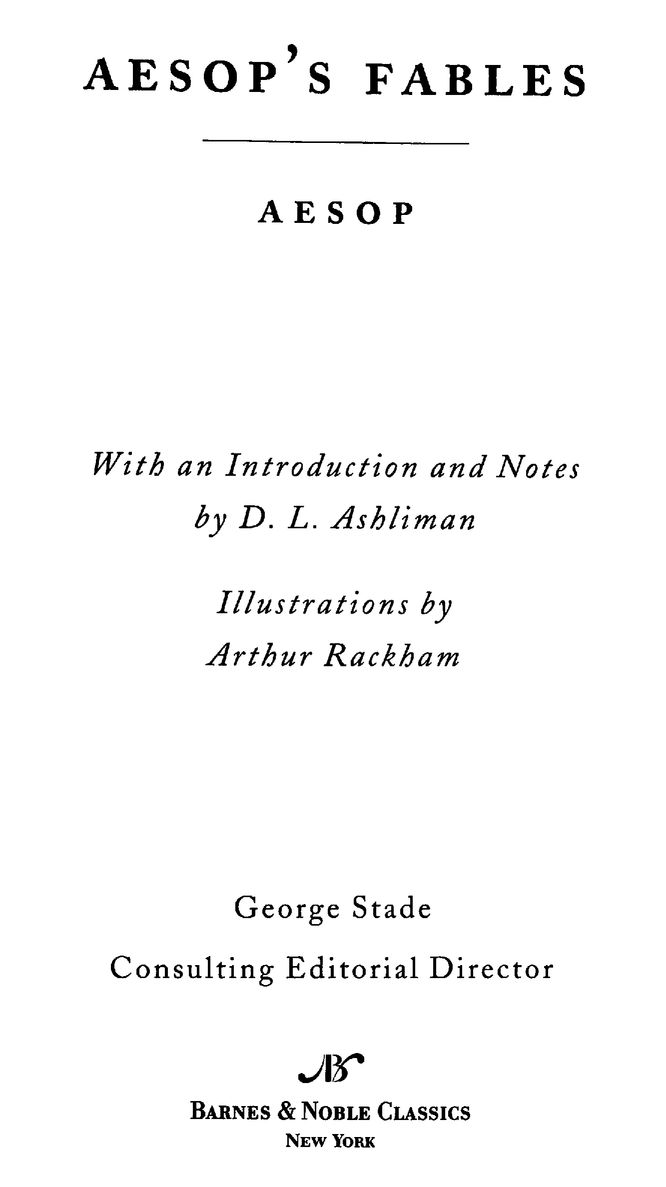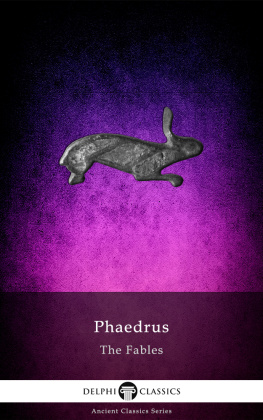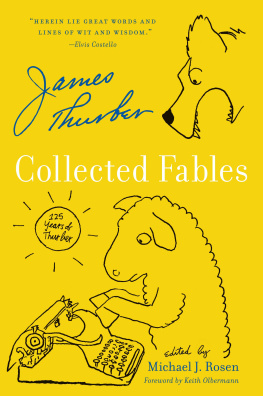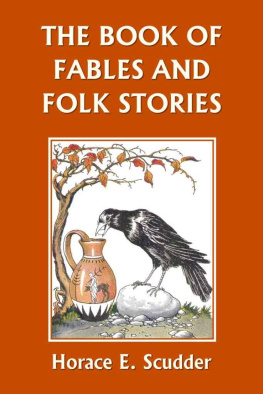
Table of Contents

BARNES & NOBLE CLASSICS
NEW YORK
Published by Barnes & Noble Books
122 Fifth Avenue
New York, NY 10011
www.barnesandnoble.com/classics
The present text of Aesops Fables derives from V.S. Vernon Joness edition published by W. Heinemann in 1912. Spelling and punctuation have been Americanized, printers errors corrected, and capitalization standardized throughout.
Published in 2003 by Barnes & Noble Classics with new Introduction, Notes, Biography, Chronology, Map, Inspired By, Comments & Questions, and For Further Readingl
Introduction, Notes, and For Further Reading
Copyright 2003 by D. L. Ashliman.
Note on Aesop, The World of Aesop and His Fables,
Inspired by Aesops Fables, and Comments & Questions
Copyright 2003 by Fine Creative Media, Inc.
All rights reserved. No part of this publication may be reproduced or transmitted in any form or by any means, electronic or mechanical, including photocopy, recording, or any information storage and retrieval system, without the prior written permission of the publisher.
Barnes & Noble Classics and the Barnes & Noble Classics colophon are trademarks of Barnes & Noble, Inc.
Aesops Fables
ISBN-13: 978-1-59308-062-4
eISBN : 97-8-141-14317-1
ISBN-10: 1-59308-062-X
LC Control Number 2003108022
Produced and published in conjunction with:
Fine Creative Media, Inc.
322 Eighth Avenue
New York, NY 10001
Michael J. Fine, President and Publisher
Printed in the United States of America
QM
9 10 8
AESOP
Aesop may not be a historical figure but rather a name that refers to a group of ancient storytellers. And if a man named Aesop did exist, it is unlikely that he committed any of his immortal fables to paper. After his presumed date of death several centuries passed before the first reliably known written collection of the stories appeared. What, then, is known of this elusive author, of whose true identity, like Homers, we have but a hazy impression?
Tradition says that around 620 B.C., Aesop was born a slave in one of the ancient city-states in Asia Minor, on the Greek island of Samos, or in Ethiopia or another locale. A man named Xanthus owned him first, and then ladmon; because of Aesops marvelous wit and capacious intellect, ladmon gave him his freedom. According to Plutarch, Aesop served as a shrewd and capable emissary to the wealthy Croesus, king of Lydia, who employed the fabulist in his court, where he dined with philosophers and from which he traveled on ambassadorial missions. The brilliant storyteller reportedly journeyed throughout Greece, doing business for Croesus and delighting the citizens of many cities with his fables.
As the fables that bear his name suggest, Aesop must have been a clever and wisely observant man, but according to one account of his death, his keen sense of human behavior was his undoing. Croesus had entrusted Aesop with a fortune in gold and sent him as an emissary to Delphi, with instructions to spread the sum throughout the land. But the avarice of the citizens disgusted Aesop, and he declined to hand out the money. Sadly, his mistrust of the people was well founded, for they executed Aesop, some say by hurling him from a cliff-top.
The death of Aesop the man had little impact on the life of his works, and collections of Aesops fables grew and flourished through the ages, in both written and oral form. They were among the first printed works in the vernacular European languages, and writers and thinkers throughout history have perpetuated them to such an extent that they are embraced as among the essential truths about human beings and their ways.
THE WORLD OF AESOP AND HIS FABLES
| c. 2000 B.C | In ancient Mesopotamia proverbs and fables featuring animals are recorded on clay tablets. Probably based on older material, now lost, such stories were most likely invented independently in more than one place; prehistoric travelers car ried them back and forth across the world. |
| c. 620 | Aesop was born a slave or possibly captured into slavery at an early age; his birthplace might have been Thrace, Phrygia, Samos, Athens, Sardis, or Ethiopia. As a young man he was taken by a slave trader to what is now Turkey. When no one would buy him, he was taken to the island of Samos, where a man said to be a philosopher called Xanthus purchased him as a servant for his wife. Later he was owned by Iadmon, a Samian, who gave Aesop his freedom. |
| Seventh-sixth centuries | The Seven Sages of GreeceSolon of Athens, Chilon of Sparta, Thales of Miletus, Bias of Pri ene, Cleobulus of Lindos, Pittacus of Mitylene, and Periander of Corinthare revered as the source of the highest practical wisdom. According to Plutarch, Aesop is a guest at one of the sages banquets. |
| c. 560 | Aesops cunning, wisdom, and oratory had freed |
| him from slavery, but this year they will cost him his life. The citizens of Delphi, offended by perceived insults to their aristocracy and the god Apollo, plant a golden cup in his baggage, then accuse him of having stolen it; they execute Aesop by throwing him off a cliff. |
| 425 | In his History of the Greco-Persian wars, the Greek historian Herodotus writes about Aesop. |
| 422 | In his comedy Wasps, Aristophanes notes that, at banquets in ancient Athens, a common entertainment was the telling of anecdotes and comic stories in the style of Aesop. |
| 360 | Plato records in his dialog Phaedo that Socrates, in prison awaiting execution, had diverted himself by writing some of Aesops fables in verse. |
| c. 300 | In Athens, Demetrius Phalareus may compile the first collection of fables attributed to Aesop, but it will not survive after about 900 A.D. In India, the first of the didactic Jataka tales are written and will continue to be recorded until about 400 A.D.; many are based in ancient folklore and have close parallels in Aesop. Part of the canon of sacred Buddhist literature, the collectionsome 550 anecdotes and fablesdepicts early incarnations of the Buddha. |
| c. 100 | In India, a Sanskrit collection of tales is collected that will form the basis for the Panchatantra (see third and fourth centuries A.D.). |
| First century | The Roman poet Horace records, in his Satires, one of the most famous of Aesops fables, The Town Mouse and the Country Mouse (no. 141). |
| c. 15 B.C. | Phaedrus is born as a slave in Thrace; at a young age he moves to Italy, where he gains his freedom. He will live until 50 A.D. |
| First century A.D. | In Rome, Phaedrus records the oldest surviving collection of Aesopic fables in Latin iambic verse; the five books of his collection contain |
| some 94 fables. Later editors will rely heavily on Phaedrus as a source for their Aesops fables. |
| Second century | Babrius, probably a Hellenized Roman, assembles the oldest extant collection of Aesopic fables in Greek. It includes more than 200 fables, 143 of which are still extant in verse form; 57 others have survived paraphrased in prose. Babriuss Aesopic fables will also serve as a source for later editors. |














